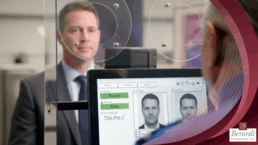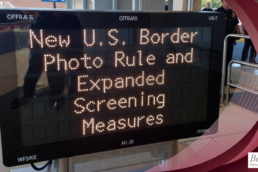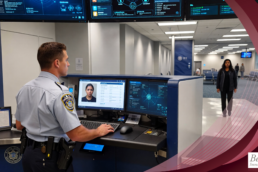If you cross the U.S.-Canada border regularly, for business, family, or leisure, mark your calendar for December 26, 2025.
On that date, the Department of Homeland Security (DHS) will begin photographing every non-U.S. citizen entering or leaving the country, including Canadians who have historically been exempt from this process.
This is not a new visa requirement. You won’t need to complete extra forms or pay additional fees. However, it does represent a major shift in how border security and traveler identification will be managed going forward.
“For cross-border professionals and employers with Canadian staff, preparation and awareness are crucial,” says Rosanna Berardi, Esq., Managing Partner of Berardi Immigration Law. “This change won’t alter your visa eligibility, but it will change your experience at the border. Understanding the process ahead of time will help you avoid unnecessary delays.”
The facial recognition photo does not replace the inspection or interview process, it simply replaces the need for officers to manually verify your identity using a passport scan or visual comparison. The goal is to speed up identity confirmation, not to eliminate human interaction. The CBP officer will still ask the usual inspection questions, like your travel purpose, destination, and length of stay, to confirm admissibility.
What’s changing is how your identity is confirmed, not whether you’re inspected. Facial comparison technology verifies that you are who you say you are within seconds, allowing officers to spend more time on meaningful screening rather than administrative steps.
Why Is This Happening Now?
For more than two decades, the U.S. has struggled with what’s known as the “exit gap,” a lack of consistent data showing who actually leaves the country.
Since 2004, Customs and Border Protection (CBP) has photographed most foreign nationals upon entry, but until recently, it had no comprehensive way to confirm departures. That gap created vulnerabilities in tracking visa overstays and verifying traveler identities.
Following years of pilot programs and technology testing, facial comparison systems have proven both fast and accurate. The technology can match travelers to their passport or visa photos in seconds, with a reported 98% accuracy rate.
The 2025 “One Big Beautiful Bill” finally allocated full funding to expand this system nationwide. With the technology refined and tested, DHS is ready to implement the final stage: mandatory photos for all non-U.S. citizens at both entry and exit.
What Changes on December 26, 2025
Here’s what you can expect under the new rule:
- All non-U.S. citizens, including Canadian nationals, will have their photo taken upon both entry and exit.
- No age exemptions. Infants, children, and elderly travelers will all be photographed.
- Applies to all ports of entry: Air, sea, and land crossings.
- No new fees, forms, or interviews. The process is automatic and touchless.
For most travelers, this will add only a few seconds to your inspection or boarding process. CBP officers will use facial comparison technology to match the live photo to your existing government records, such as your passport or prior entry photos.
If there’s no match (for instance, if your photo is outdated or lighting interferes with recognition) the officer will simply revert to a manual document check.
What Canadians Should Know
While the expansion may sound intimidating, nothing changes about your legal status or visa exemptions.
Canadian citizens remain exempt from:
- fingerprinting (unless there’s a specific security reason);
- the I-94 form for business visitors and tourists; and
- any new visa or fee requirements.
Your TN or L-1 application process also remains the same. The only difference is that your photo will now be taken upon entry and exit.
Rosanna Berardi adds:
“If your employees travel frequently between Canada and the U.S., make sure they know this process is coming. It’s purely an identity verification measure, not a change to immigration law. Encourage them to keep passports current and allow a little extra time at the border early next year.”
How the Process Works
- At Land Crossings:
As you approach the inspection booth, a camera positioned at eye level captures your image automatically. The officer’s screen displays the match result within seconds. - At Airports and Seaports:
Cameras at boarding gates capture your image as you board. The system verifies you against flight or passenger manifests and confirms departure. - Data Privacy and Retention:
Photos of non-citizens are kept briefly for system checks, then transferred securely to DHS databases. CBP and its partners, like airlines, must follow strict data protection rules and cannot use your biometric data for any other purpose.
Practical Tips for a Smooth Crossing
- Update your passport photo. If your appearance has changed significantly since your last renewal, consider getting a new passport to avoid recognition issues.
- Allow extra time early in 2026. Expect brief delays as travelers and officers adjust to the new technology.
- Use trusted traveler programs. If you have NEXUS or Global Entry, your biometric photo will integrate seamlessly with these systems.
- Download the CBP Mobile Passport Control app. It can help speed up your inspection process at participating airports.
- Stay calm if there’s a mismatch. The officer will simply conduct a manual check, no penalties or complications.
How Employers Can Prepare for New Facial Recognition Policy
Businesses with Canadian employees or cross-border operations should:
- Notify staff who travel frequently about the new process.
- Avoid scheduling first crossings under the new rule during high-traffic times.
- Reassure employees that their visa categories, like TN or L-1, are not affected.
If you encounter travel issues or notice inconsistencies in CBP records, contact the CBP Information Center or submit a Traveler Redress Inquiry (DHS TRIP). For complex cases, consult an immigration attorney.
What This Means for Border Travelers
For legitimate travelers, this is a positive development. The new system will increase accuracy, enhance security, and reduce manual errors, all while streamlining inspection times.
By late 2026, CBP expects border crossings to move even faster than before. While the transition may feel like an adjustment, the process is designed to be quick, private, and nearly invisible to most travelers.
FAQs About the New Facial Recognition Requirement
Will Canadians need to register online or complete any new paperwork?
No. Canadians do not need to pre-register or file new forms. The process is automatic when you cross.
What if the system doesn’t recognize me?
Don’t worry. CBP will perform a manual identity check using your passport. You will not be penalized for a technical mismatch.
Stay Informed, Not Alarmed
The facial recognition rule takes effect December 26, 2025, but travelers should view it as an evolution in efficiency, not a barrier.
For Canadians and frequent cross-border travelers, this will likely simplify your experience over time by speeding up entry and departure verification.
If you have questions about how this rule may affect your travel or workforce, Berardi Immigration Law is here to help you navigate every step. Ready to talk about your cross-border workforce or business travel? Call our office or click this link to schedule a consultation.
Ready to have Berardi on your side?
Whether you’re a business looking to hire or a professional hoping to relocate, immigration law can be complicated. But you don’t have to do it alone. Put our experience to work for you.



